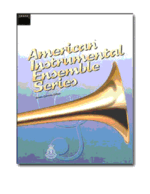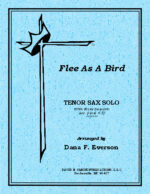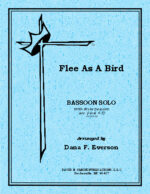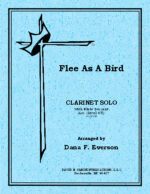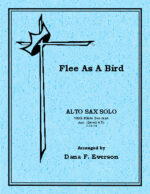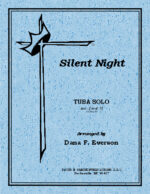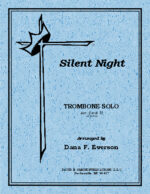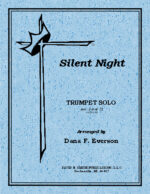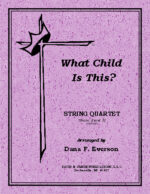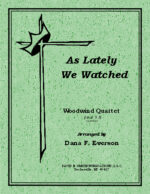-
Rondeau
$29.95Originally written as the first movement of an instrumental suite, Mouret’s Rondeau has remained his most popular work. It is frequently heard at weddings and other ceremonies. A rondeau is a form of dance music that contains an initial theme that is reiterated throughout the piece.
-
Prelude on “Beethoven”
$29.95Though the historical background for the hymn tune “Beethoven” seems nebulous, it has been effectively paired with many hymn texts. Here, the composer’s Prelude is based on the thought-provoking text by Frances Ridley Havergal (1836-1879), “Lord, speak to me that I may speak.”
Prelude on “Beethoven” includes settings of two verses. The first instance utilizes the first verse of Havergal’s text in a sensitive, somewhat pastoral fashion, which is introduced by the composer’s original melodic material. The second setting, based on verse seven, reflects the climactic nature of the text.
Verse 1
Lord, speak to me, that I may speak in living echoes of Thy tone.
As Thou hast sought, so let me seek Thy erring children lost and lone.Verse 7
O use me, Lord, use even me, Just as Thou wilt and when and where,
Until Thy blessed face I see, Thy Rest, Thy joy, Thy glory share. -
Nearer, My God To Thee
$29.95When Jesus visited Mary and Martha in Bethany, he brought assurance both of communion with him and of his resurrection. It is quite fitting, therefore, that Lowell Mason should name his hymn tune “Bethany” to remind us of that assurance through the hymn’s well-loved text, “Though it be a cross that raiseth me, still all my song shall be, nearer, my God, to thee!”
-
March from “Scipione”
$29.95This march, from George Frideric Handel’s opera Scipione was composed in 1725 and received its first public performance a year later in England. The march appears in the last section of the opera’s overture and again at the start of the action. This is lively music from the late Baroque period and has often been rescored for solo instruments as well as large ensembles.
-
Lonesome Valley
$29.95This folksong-like melody has been appearing in hymnals for many years as “Jesus Walked This Lonesome Valley.” Its origins are shrouded in obscurity and can be traced to the Appalachian mountains of the southeastern United States.
The refrain of the song includes these words:
Jesus walked this lonesome valley; he had to walk it by himself.
Oh, nobody else could walk it for him; he had to walk it by himself. -
Listen To The Lambs
$29.95One of the lesser-known American spirituals, “Listen To The Lambs,” was first published in 1914. Perhaps one of its most lasting recordings was made in 1955, sung a capella by the Tuskegee Institute Choir.
The text is drawn from an older spiritual, “I Want To Go To Heaven When I Die.” Here, it is given a rhythmic setting featuring a light Latin rhythmic backing to its haunting melody.
-
Life, Joy and Peace (Solo Bb/C)
$29.95Based on the wonderful old gospel song, “‘Tis so Sweet to Trust in Jesus” by Louisa M.R. Snead (1850-1917) and William James Kirkpatrick (1838-1921), this solo with instrumental ensemble accompaniment features one verse and two choruses from the song.
After a brief introduction based on intervals from the song, the soloist plays an original melody by the composer prior to a light and energetic rendition of the first chorus. The verse appears in a more sustained style by the soloist, accompanied by a smooth, chorale-like background.
The second chorus is played by the soloist while the opening original theme is juxtaposed underneath. The introduction is reintroduced prior to an ascending finale by the soloist. -
Life, Joy and Peace (Solo Bb/C)
$9.95Based on the wonderful old gospel song, “‘Tis so Sweet to Trust in Jesus” by Louisa M.R. Snead (1850-1917) and William James Kirkpatrick (1838-1921), this solo with instrumental ensemble accompaniment features one verse and two choruses from the song.
After a brief introduction based on intervals from the song, the soloist plays an original melody by the composer prior to a light and energetic rendition of the first chorus. The verse appears in a more sustained style by the soloist, accompanied by a smooth, chorale-like background.
The second chorus is played by the soloist while the opening original theme is juxtaposed underneath. The introduction is reintroduced prior to an ascending finale by the soloist. -
I Want Jesus To Walk With Me
$29.95African American spirituals are a rich part of our nation’s history – offering songs of hope for the oppressed as well as soulful hymns for the Church. “I Want Jesus to Walk With Me” is one such spiritual. While the text references many trials that must be endured, it maintains a sense of hope. It is a prayer to God to be with us throughout all our life, and with Jesus, we will overcome the trials.
The tune follows a similar pattern. Even though the melody is in a minor key, the repetitive form and quick tempo portray an upbeat thought, despite the trials that are being depicted.
-
Happy Land
$29.95Andrew Young (1807-1891) spent his life in Edinburgh, Scotland where he was a school teacher and head master. Many of Mr. Young’s hymns and poems were published in 1876 as The Scottish Highlands and Other Poems, which included “There Is a Happy Land,” which is included in many hymnals to this day. Its theme of eternal life and peace is summed up in the first verse:
There is a happy land, far, far away,
Where saints in Glory stand, bright, bright as day.
O how they sweetly sing: Worthy is our Savior King!
Loud let His praises ring, praise, praise for aye. -
Grace Alone
$29.95Grace Alone is a simple, lovely, and moving song by Scott Wesley Brown and Jeff Nelson. Its message of hope and assurance is particularly appropriate today. This song also reminds us of Christ’s service and our responsibility to others, admonishing us to “go forth in grace alone.”
-
Fanfare Overture on St. Anne
$29.95The hymn tune “St. Anne” was composed in 1708 by William Croft, the organist at St. Anne’s Church, Soho, London. The words, “O God Our Help in Ages Past” were written by Isaac Watts, also in 1708, as a paraphrase of Psalm 90. For a hymn, the tune is remarkably strong and resolute and has often been used by other composers, notably J. S. Bach and Handel, as the basis for different compositions.
This particular “fanfare overture” setting of the tune is somewhat in keeping with the contrapuntal uses that were in fashion when the tune was originally composed. Instead of standard percussion, for example, timpani alone are used, a reference in style to the celebratory percussion and trumpet combinations of the 18th century.
-
Christ The Lord Is Risen Today (Solo Eb/F)
$29.95The great Charles Wesley hymn Christ the Lord is Risen Today has here been set as a solo for instrument in E-flat or F with ensemble accompaniment by Andrew Wainwright. The hymn is widely considered as the most definitive church anthem for Easter, celebrating the resurrection of Jesus.
-
Christ The Lord Is Risen Today (Solo Eb/F)
$9.95The great Charles Wesley hymn Christ the Lord is Risen Today has here been set as a solo for instrument in E-flat or F with ensemble accompaniment by Andrew Wainwright. The hymn is widely considered as the most definitive church anthem for Easter, celebrating the resurrection of Jesus.
-
Best Friend Forever
$29.95Colonel Edward H. Joy (1871-1949) had a long career as a Salvation Army officer who served in several administrative appointments in the United Kingdom, Canada, and South Africa from 1894 to 1938. Throughout his ministry, he wrote the words and music to many well-loved songs, including the melody featured here, “All Your Anxiety.” It is a song of invitation, as stated in the chorus:
All your anxiety, all your care,
Bring to the mercy seat, leave it there,
Never a burden He cannot bear,
Never a friend like Jesus. -
Flee As A Bird (with flute descant)
$7.50The piece begins with the solo and descant presenting the tune in unison with few modifications. This texture continues on in this manner allowing the descant to act as a color. The next section is an question/answer form with the soloist alternating against the flute and piano. The third section pairs the solo line and descant in much the same manner as the opening. The piece comes to a subtle conclusion. The piece, as a whole depicts a bird flying and flittering about in glee.
-
Flee As A Bird (with flute descant)
$7.50The piece begins with the solo and descant presenting the tune in unison with few modifications. This texture continues on in this manner allowing the descant to act as a color. The next section is an question/answer form with the soloist alternating against the flute and piano. The third section pairs the solo line and descant in much the same manner as the opening. The piece comes to a subtle conclusion. The piece, as a whole depicts a bird flying and flittering about in glee.
-
Flee As A Bird (with flute descant)
$7.50The piece begins with the solo and descant presenting the tune in unison with few modifications. This texture continues on in this manner allowing the descant to act as a color. The next section is an question/answer form with the soloist alternating against the flute and piano. The third section pairs the solo line and descant in much the same manner as the opening. The piece comes to a subtle conclusion. The piece, as a whole depicts a bird flying and flittering about in glee.
-
Flee As A Bird (with flute descant)
$7.50The piece begins with the solo and descant presenting the tune in unison with few modifications. This texture continues on in this manner allowing the descant to act as a color. The next section is an question/answer form with the soloist alternating against the flute and piano. The third section pairs the solo line and descant in much the same manner as the opening. The piece comes to a subtle conclusion. The piece, as a whole depicts a bird flying and flittering about in glee.
-
Silent Night
$4.50An accompanied tuba solo that begins with a gentle piano introduction. The soloist then presents the tune with subtle modifications. The second section progresses with even greater melodic enhancement. With a modulation the solo deviates the melody with an almost obbligato-like fashion. With further modulation the solo line gravitates to a style reminiscent to the second section. The coda section is patterned after the first section and then settles down to sweet silence.
-
Silent Night
$4.50An accompanied trombone solo that begins with a gentle piano introduction. The soloist then presents the tune with subtle modifications. The second section progresses with even greater melodic enhancement. With a modulation the solo deviates the melody with an almost obbligato-like fashion. With further modulation the solo line gravitates to a style reminiscent to the second section. The coda section is patterned after the first section and then settles down to sweet silence.
-
Silent Night
$4.50An accompanied trumpet solo that begins with a gentle piano introduction. The soloist then presents the tune with subtle modifications. The second section progresses with even greater melodic enhancement. With a modulation the solo deviates the melody with an almost obbligato-like fashion. With further modulation the solo line gravitates to a style reminiscent to the second section. The coda section is patterned after the first section and then settles down to sweet silence.
-
What Child Is This?
$10.50A string quartet with optional third violin for viola. After a brief introduction the theme is presented in a straight forward ensemble harmonization with some altered pitches. The next section places the melody in the viola line with opposing lines in the violins. The ensuing section now gives the tune to the second violin with contrapuntal action in the other voices. A chorus section is now more articulated and active until the tune is handed to the first violin with ever more moving counterpoint in the other voices. The piece then ends in a strong statement.
-
As Lately We Watched
$11.00A woodwind quartet with optional parts is presented in a joyful manner giving a sense of expectation. After a pert introduction, the melody is stated with a solo clarinet with answering figures rotated amongst the other voices. A joyful bridge section gravitates towards a modulation with the tune stated in the lower voices. The piece goes into a free, flourishing motion where it heads into yet another modulation. The tune now is doubled in the flute and clarinet with accompaniment figures moving in hemiola sets. After a set of imitation figures passed about the ensemble the piece goes into a coda section with more joyful figures.
-
Come To The Manger
$8.00An accompanied sax trio (A-A-A/T) opening with an exciting motive. The first rendition is in block harmonies with occasional rhythmic punctuations. The next section has subtle contrapuntal statements amongst all parts giving a joyous texture. After a modulation the ensemble alternates between solo statements and full ensemble giving contrasts in texture and color. Another modulation ensues where imitative motives take place through the voices only to come together in a solid fashion for an exciting ending.

